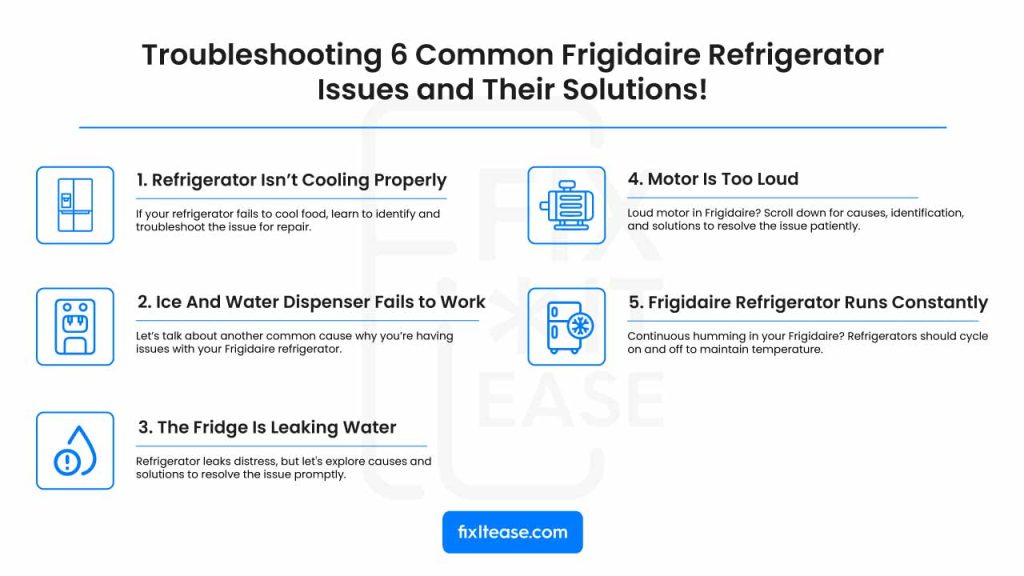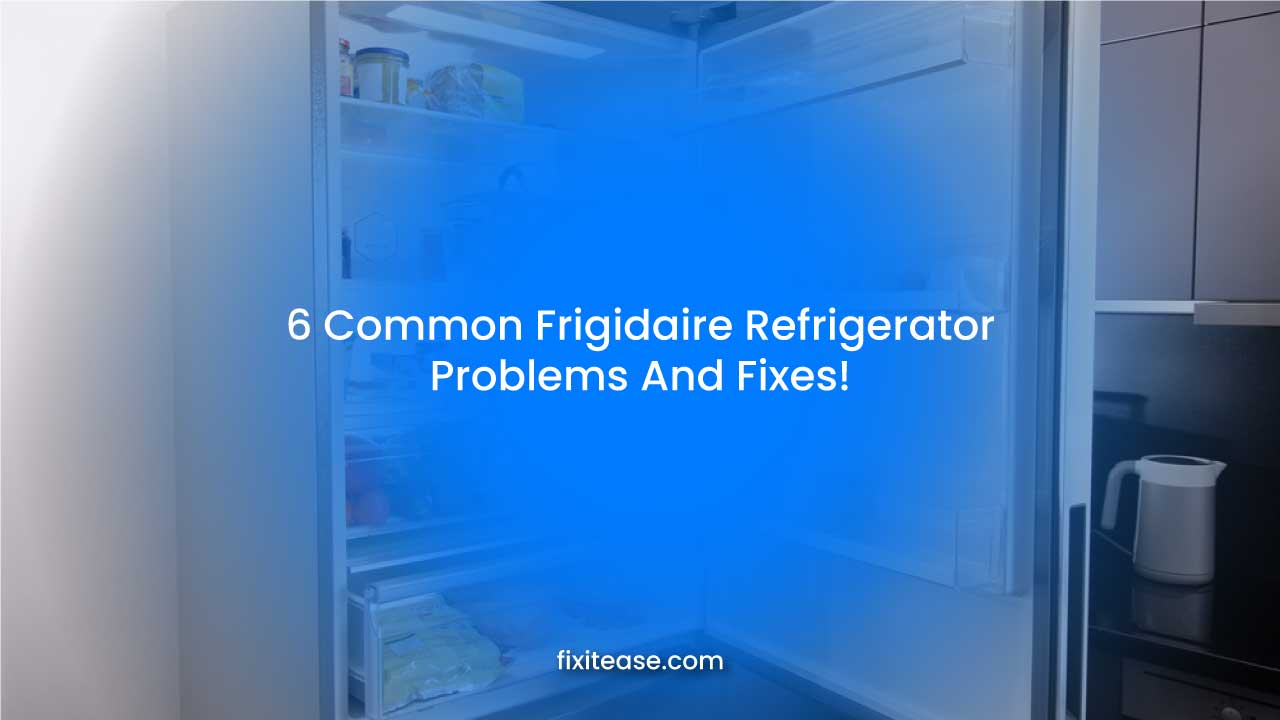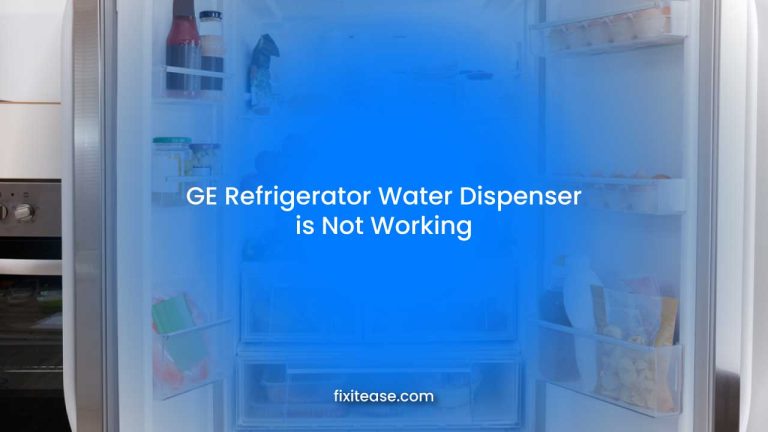6 Common Frigidaire Refrigerator Problems And Fixes!
Although the Frigidaire refrigerator owners get lots of benefits from the fridge, there are some times when the fridge malfunctions and bother the user. But there are easy fixes to the common Frigidaire refrigerator problems so you don’t have to worry much about them.
Some of the common Frigidaire refrigerator problems are- the refrigerator doesn’t cool properly, the ice and water dispenser fails to work, the fridge leaks water, the fridge makes too loud noise, and so on.
Keep reading to find out what’s the root of the issues and how you can fix the problems.
Troubleshooting 6 Common Frigidaire Refrigerator Issues and Their Solutions!

We won’t beat around the bush, let’s get into the core of the discussion immediately.
1. Refrigerator Isn’t Cooling Properly
It can be frustrating when your refrigerator fails to do its main job; cooling the foods inside. Here’s how you can identify the problem and fix it.
What Causes It
- Temperature Settings: Inaccurate temperature settings or changes in settings due to accidental touch can lead to insufficient cooling.
- Exceeding Storage Capacity: Overcrowding the fridge with too much food can restrict airflow, resulting in temperature fluctuations.
- Dirty Condenser Coils: Dust and dirt accumulation on the condenser coils can hinder their cooling efficiency.
- Door Seal Issues: A damaged or dirty door seal allows cold air to escape and warm air to enter, disrupting cooling.
- Internal Component Failures: Problems with components like evaporator or condenser fan motors, thermostats, or start capacitors can impair the refrigerator’s cooling ability.
How to Identify
A warm refrigerator is a clear indicator that something isn’t right. If you notice your Frigidaire refrigerator failing to maintain the desired temperature, here’s how to identify the issue:
- Check the temperature settings on your fridge.
- Assess the state of the refrigerator’s internal components.
- Examine the condition of the rubber seal along the door’s perimeter.
- Listen for unusual noises or lack of typical refrigerator sounds.
- Keep an eye on the refrigerator’s performance over a few hours or days to confirm the issue.
How to Fix It
- Adjust Temperature Settings: Ensure the temperature settings are accurate and set to the recommended range, usually between 35-37℉.
- Optimize Storage: Arrange items in your fridge strategically, keeping them away from air vents to allow proper airflow. Avoid overloading the refrigerator, as this can impact its cooling efficiency.
- Clean Condenser Coils: To clean the condenser coils, refer to your refrigerator’s user manual to find the condenser coils first. They’re typically located behind an access panel on the rear or behind a front grille at the bottom.
Unplug your refrigerator to ensure safety during the cleaning process. Then, remove the access panel or grille to access the coils. Clean the coils and the surrounding area using a narrow hose vacuum attachment to remove dirt and debris. Use an appliance brush to eliminate any lingering dirt. Vacuum any remaining dust and dirt on the floor. After cleaning, replace the panel or grille and plug the refrigerator back in.
- Inspect Door Seal: Check the rubber seal along the door’s perimeter for dirt, debris, or any signs of damage such as rips or tears. If the seal is dirty, clean it with a damp cloth to ensure a tight seal. If the seal is damaged, it’s advisable to replace it to maintain an airtight closure.
How to Prevent It
- Regularly clean condenser coils every 6 months.
- Be mindful of temperature settings, especially if you have children at home.
- Maintain proper storage practices to allow for efficient airflow.
- Keep an eye on the condition of the door seal and replace it if damaged.
2. Ice And Water Dispenser Fails to Work
Let’s talk about another common cause why you’re having issues with your Frigidaire refrigerator.
What causes it:
- A clogged or old water filter: Over time, the water filter in your refrigerator can accumulate sediment and impurities, leading to reduced water flow to the dispenser. This can result in slow or no water and ice production. A clogged or outdated filter can significantly impact the quality and quantity of dispensed water and ice.
- Issues with the water line or low water pressure: Your refrigerator’s water and ice dispenser relies on a consistent and adequate water supply. Several issues can disrupt this supply. A misaligned or kinked water supply line, frozen water line, low water pressure, or a defective water inlet valve can all interfere with the flow of water to the dispenser. These issues can lead to intermittent or no water and ice dispensing.
- Damaged dispenser switches: The dispenser switches provide the electrical signals required to operate the dispenser. When these switches are damaged or malfunction, they may fail to supply power to the dispenser. This can result in the dispenser not working at all.
- A malfunctioning dispenser control board: The dispenser control board is like the “brain” of your refrigerator’s dispenser system. It controls and coordinates the various components, such as the water and ice functions. If the control board malfunctions, it can disrupt the operation of the entire system, leading to a complete failure of the dispenser.
How to Identify
- No water or ice is dispensed: When you attempt to get water or ice, nothing comes out.
- Slow or intermittent water flow: The water or ice dispenser operates, but the flow is sluggish or uneven.
- Ice maker not producing ice: You experience issues with the ice-making function of the dispenser.
How to Fix it:
- Check the Water Filter: Access the location of your water filter. Refer to your refrigerator’s user manual for specific instructions, as filter placement can vary. Inspect the filter for any visible clogs or contaminants.
If the filter appears dirty or clogged, it’s a clear sign that it needs to be replaced. Replace the water filter with a new one. Ensure you use the correct filter type recommended for your specific refrigerator model.
- Inspect the Water Supply: Carefully move the refrigerator away from the wall to access the water supply line. Check the water line for any kinks or obstructions. If you find any kinks, gently straighten them to ensure an uninterrupted water supply.
If you suspect a frozen water line, use a hairdryer to carefully thaw the line. Ensure that the freezer’s temperature remains within the recommended range (usually between 0 and 10 degrees Fahrenheit) to prevent future freezing.
Confirm that your home’s water pressure is within the recommended range. The water pressure should be at least 20 psi for the water inlet valve to function correctly. If your home’s water pressure is too low, consider increasing it.
If the water inlet valve is found to be defective after these checks, it may need to be replaced.
- Examine the Dispenser Control Board: If you observe that specific dispenser components, such as the ice or water function, are not working while others are functioning correctly, inspect each component for damage or malfunction. Replace any defective components to restore normal operation.
If the entire dispenser system is not functioning, the dispenser control board may be at fault. In this case, please contact a qualified technician to diagnose and replace the control board.
- Test Dispenser and Door Switches: Use a multimeter to test each dispenser switch for continuity. If a dispenser switch does not have continuity when activated, it should be replaced with a new one.
How to Prevent It
- Regularly replace the water filter every six months.
- Ensure the water supply line is not kinked or frozen.
- Maintain adequate water pressure in your home.
- Conduct routine checks for continuity on dispenser switches.
3. The Fridge Is Leaking Water
I know that it feels worse when you see your refrigerator leaking water. Here’s what it causes and how you can get rid of the issue. Let’s check them out.
What causes it:
- Clogged or Frozen Defrost Drain: One of the most common reasons for a refrigerator leaking water is a clogged or frozen defrost drain. When this drain gets blocked, water from the defrost cycle has nowhere to go and can leak inside or outside the refrigerator.
- Damaged or Misaligned Water Filter: If your refrigerator leaks water around the water filter area, it could be due to a misaligned or damaged water filter.
- Cracked or Damaged Drain Pan: The drain pan is a critical component that collects water generated during the defrost cycle. It’s usually located at the bottom of the refrigerator. If this pan is cracked or damaged in any way, the water it’s supposed to collect can escape onto your kitchen floor. This situation is not only messy but also an indicator that the drain pan requires attention.
- Leaking Water Supply Line or Valve: The water supply line connects your fridge to your home’s water source. If this line is compromised, either due to damage or loose connections, it can lead to leaks. Similarly, the water inlet valve, which controls the flow of water to the dispenser and ice maker, can develop cracks or other issues that result in leaks.
How to Identify
- Water pooling around or under the refrigerator.
- Wet spots on your kitchen floor.
- Visible water inside the fridge compartments.
How to Fix it:
- Thaw the Clogged or Frozen Defrost Drain: Unplug the refrigerator and locate the defrost drain, usually at the back or bottom of the unit. Use warm water, a turkey baster, or a small funnel to flush the drain. You can also try a warm water and vinegar mix to dissolve debris. If the drain is frozen, use a hairdryer to gently thaw it.
- Refine or Replace the Damaged or Misaligned Water Filter: Check if the water filter is properly installed and seated. Realign it if necessary. Inspect the water filter for visible damage. If damaged, replace it with an OEM replacement filter.
- Fix the Cracked or Damaged Drain Pan: Locate the drain pan, usually at the bottom of the refrigerator. Inspect it for cracks or damage. If found, it may need professional replacement.
- Deal With the Leaking Water Supply Line or Valve: Inspect the water supply line and inlet valve for damage or loose connections. Tighten connections or replace damaged parts. If you’re unsure about these tasks, consider professional help.
How to Prevent It
- Regularly check the defrost drain for clogs and clear them promptly.
- Ensure the water filter is correctly installed and replace it as recommended.
- Maintain the drain pan’s integrity.
- Periodically inspect the water supply line and connections.
- Keep the door gasket in good condition and replace it if needed.
4. Motor Is Too Loud
You may notice a loudy motor in your Frigidaire refrigerator. To know what causes it, how to identify the issue, and what the solution is, please scroll down with patience.
What causes it:
- Faulty Evaporator Fan Motor: If your Frigidaire refrigerator emits a high-pitched squeal or chirping noise, it’s likely due to a defective evaporator fan motor. This fan is responsible for circulating air over the evaporator coils to maintain the refrigerator’s cool temperature. When the fan’s motor malfunctions, it produces these disruptive sounds.
- Worn Out Condenser Fan Motor (Grinding Noise): Another common cause for a noisy Frigidaire refrigerator is a worn-out condenser fan motor. This motor assists in drawing room air over the condenser coils and compressor to aid in cooling. Because it is often located at the back of the refrigerator, it’s susceptible to debris and dust accumulation, which can lead to increased noise.
- Compressor Noise: Excessive noise can also be an indicator of problems with the compressor. The compressor plays a vital role in circulating coolant throughout the fridge to maintain the desired temperature. When the compressor is failing, it may produce loud and unusual sounds, signifying an impending issue.
How to identify it:
Identifying that your refrigerator’s motor is making excessive noise is usually straightforward. You’ll notice sounds like buzzing, squealing, grinding, or clacking that are not typical for your fridge’s operation. These noises often indicate underlying issues with the motor or associated components.
How to Fix It:
- Fix the Faulty Evaporator Fan Motor (Squealing or Chirping Noise): Unplug your refrigerator and clear out the freezer to access the evaporator fan. Unscrew the back panel to reach the fan. Check if the fan moves freely and inspect wires and connectors for damage. If the fan is damaged or the connections are faulty, it’s best to seek professional replacement.
- Deal with the Worn Out Condenser Fan Motor: Move the refrigerator away from the wall, disconnect the power source, and unscrew the back panel. Clean away any accumulated dust and debris around the condenser fan. Tighten loose screws around the fan to ensure stability. If these measures don’t resolve the problem, professional assessment and repair are recommended.
- Compressor noise: Compressor problems are complex and usually require professional diagnosis and repair. If you suspect issues with the compressor, contact a qualified technician to assess and resolve the problem.
5. Frigidaire Refrigerator Runs Constantly
Is your Frigidaire refrigerator seemingly never taking a break from its constant hum? A refrigerator should run in cycles, turning on and off as needed to maintain the desired temperature.
When it runs continuously, it’s essential to investigate the issue. In this section, we’ll explore the possible causes behind a Frigidaire refrigerator that runs non-stop and offer guidance on how to address it.
What Causes It
- Internal Temperature Issues: The ideal temperature range for your refrigerator and freezer must be maintained. If the temperatures are too high, your refrigerator runs constantly to cool the interior. Check your user manual to ensure both compartments are set within the manufacturer’s recommended temperature range.
- Faulty Defrost Thermostat: The defrost thermostat plays a crucial role in preventing frost buildup on refrigerator components. If it fails to signal the defrost heater to melt frost on the coils, the coils can become encased in ice, impeding cooling.
- Temperature Control Thermostat: The temperature control thermostat determines when the refrigerator’s motor starts and stops. If set at the coldest setting, your Frigidaire may run continuously. Make sure your thermostat is set within the recommended range (usually between 35 and 40 degrees Fahrenheit) to avoid overworking the refrigerator. Monitor this with a refrigerator thermometer and adjust the setting as needed.
How to Identify it:
Identifying a refrigerator that’s running constantly is not complicated. If you notice that your refrigerator’s motor never seems to turn off, despite not frequently opening the doors, you may have an issue that needs attention.
How to Fix It:
- Adjust the Internal Temperature: Make sure that both the refrigerator and freezer are set to the manufacturer’s recommended temperatures. Most refrigerators have adjustable controls for both compartments, which can be modified using push-button controls or temperature dials.
- Fix the Faulty Defrost Thermostat: If the refrigerator exhibits continuous running due to a defective defrost thermostat, professional replacement is required. Check for no continuity using a multimeter to confirm the thermostat’s malfunction.
- Adjust the Temperature Control Thermostat: Adjust the thermostat to maintain the recommended temperature range and avoid overcooling. Use a refrigerator thermometer to ensure that the internal temperature remains between 35 and 40 degrees Fahrenheit.
How to Prevent It
- Keep the refrigerator and freezer compartments at the manufacturer’s recommended temperatures.
- Perform routine checks for any obstructions or damage and take action accordingly.
FAQs
What is the biggest problem with Frigidaire refrigerators?
One of the most significant issues with Frigidaire refrigerators is their tendency to run continuously. When a Frigidaire refrigerator runs constantly, it can lead to higher energy consumption, potential food spoilage, and excessive wear and tear on the appliance. Regular maintenance and addressing these concerns promptly are essential to prevent this problem.
How do I reset my Frigidaire refrigerator?
To reset your Frigidaire refrigerator, start by locating the control panel, often found on the inside of the fridge’s fresh food compartment. Look for the “Reset” or “Filter Reset” button, press and hold it for a few seconds until the indicator light or message resets.
This is usually used for resetting the water filter or air filter status. If you’re facing specific issues or malfunctions, it’s a good idea to consult your refrigerator’s user manual or contact Frigidaire’s customer support for guidance.
Last Thoughts
Now, you know about the most common Frigidaire refrigerator problems and their solutions. From leaks to unusual noises and continuous running, understanding the causes and solutions can help keep your fridge running smoothly.
Keep an eye on temperature settings, clean the coils, and ensure seals are airtight. For more complex problems, seeking professional help is wise. Good luck!







